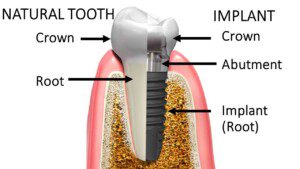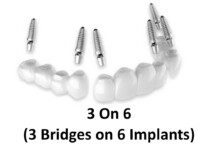
The Three Stages Unveiled
Dental implant treatment is a multi-stage process that replaces missing teeth with durable, natural-looking alternatives. Many people mistakenly think of a dental implant as the entire tooth replacement (roots and crown of the tooth), but it’s actually three parts. Basically, the dental implant replaces the missing tooth’s ROOT portion of the tooth, while the crown replaces the visible tooth/teeth part, (the crown of the tooth), and the two are connected by a device called an abutment.
This intricate procedure involves three stages:
- Implant placement
- Abutment placement
- Crown delivery
Each stage is meticulously planned and executed to ensure the longevity and functionality of the dental implant. Understanding these stages helps appreciate the complexity and precision involved in achieving a successful dental restoration that enhances both oral health and the patient’s smile.
Proper Planning is Essential
This all begins with a thorough examination and planning, including X-rays or CT scans to assess the condition of the jawbone and to determine the precise placement of the implant, and what type of temporary tooth will be used.
When dental implants are placed within our smile line (where they are visible when you smile), we provide a temporary tooth. The type of temporary tooth used will vary, depending upon the stability of the implant at the time of placement. If it’s solidly anchored into the bone, we can often make a temporary crown that gets screwed right onto the implant, and you will be instructed not to use it to bite with for a few months, while the implant integrates fully with the bone. If primary stability is not achieved at this time, a removeable tooth replacement prosthesis, such as a clear retainer with a false tooth in it or a removable partial (often referred to as a “flipper”) can be used so you can still smile without inhibition. This is all discussed and planned for in the planning phase, before the surgery.
Building a Strong Foundation: Stage 1 – Implant Placement
The first stage of dental implant treatment is the placement of the implant itself. This stage involves a surgical procedure where a titanium post is inserted into the jawbone. This titanium post acts as an artificial tooth root, providing a sturdy base for the replacement tooth. Sometimes the implant can be placed at the same time the tooth is removed. But sometimes, if the bone around the site of the root is too thin to anchor it in, bone grafting may be necessary before an implant can be placed. When this is the case, it means a longer total treatment time. Grafted bone takes several months to fully heal and become dense enough to support an implant and the chewing forces placed on it.
The Surgical Procedure
First, we administer local anesthesia to numb the area, ensuring the patient’s comfort throughout the procedure. In some cases, oral or IV sedation may be used for additional relaxation.
An incision is made in the gum to expose the jawbone. Using specialized drills, a precise hole is made in the bone, where the titanium implant is carefully placed. The implant is then screwed into position, ensuring it is flush with the bone. Unless an immediate temporary tooth is placed on the implant when it is placed, the gum is then closed over the implant, and sutures are used to facilitate healing. The sutures we use in our office are resorbable.
Osseointegration (The Waiting Period)
After the implant is placed, comes the critical stage is osseointegration. Osseointegration is a biological process where the bone grows and fuses with the surface of the implant. This typically takes a few months. It most often ranges from three to six months, depending on individual healing rates and bone quality. During this period, the implant becomes a permanent part of the jawbone, capable of withstanding the intense forces of chewing and biting. Osseointegration is essential for the stability and durability of the implant, ensuring it provides a strong foundation for the subsequent stages. Loading an implant (placing a tooth on it) before it is ready raises the risk of it failing. So, as you can see, the process of osseointegration is crucial to the long-term success of the implant. It is important not to rush this phase.
Connecting the Pieces: Stage 2 – Abutment Placement
Once osseointegration is complete, the second stage involves placing the abutment. The abutment is a small connector piece that links the implant to the final crown.
The Abutment Placement Procedure
When the implant was left under the gums at the placement surgery, this stage will begin with the reopening of the gum to expose the top of the implant. This is done using local anesthesia to minimize discomfort. Once the implant is exposed, the abutment is attached. The abutment extends above the gum line, providing a platform for the final crown to attach to. This is when we make the final impression for the permanent crown that will be placed on the implant.
The Finishing Touch: Stage 3 – Crown Delivery
The final stage of dental implant treatment is crown delivery/installation.
Creating the Custom Crown
The final impressions made after the healing period are used to create a model, which serves as a guide for designing the custom crown. We match the color of the crown to the patient’s natural teeth to ensure a seamless blend. These are highly customizable, so if your other teeth are not monochromatic, and have characterization to them, the crowns can be stained and made to match them exactly.
Attaching the Crown
Once the crown is ready, it can be attached to the abutment. This is done using special screws that fit down inside the implant. One it is screwed onto the implant, the access hole filled with a composite resin so it is not visible. Then, the doctor will ensure that the crown fits perfectly, by making any necessary adjustments to ensure comfort and functionality.
Final Adjustments and Care
Finally, the patient is then provided with oral hygiene instructions to maintain the health of implant and surrounding teeth. Proper oral hygiene practices, including regular brushing, flossing, and routine dental check-ups. These are essential for the long-term success of the dental implant, just like with natural teeth. With proper care, the dental implant can last a lifetime, providing a natural-looking and durable solution for missing teeth.
Each of these stages is essential for the success of dental implant treatment, ensuring a stable, functional, and aesthetically pleasing result. The careful planning and execution of each step are crucial for achieving a successful outcome, allowing patients to enjoy the benefits of a restored smile and improved oral health.
Conclusion
Dental implant treatment, with its three meticulously executed stages of implant placement, abutment placement, and crown delivery, offers a highly successful, comfortable and aesthetic solution for missing teeth. The success of this procedure hinges on careful planning, precise execution, and thorough aftercare. By following each stage diligently, patients can enjoy the benefits of a stable, functional, and aesthetically pleasing dental restoration that can last a lifetime.






